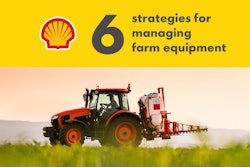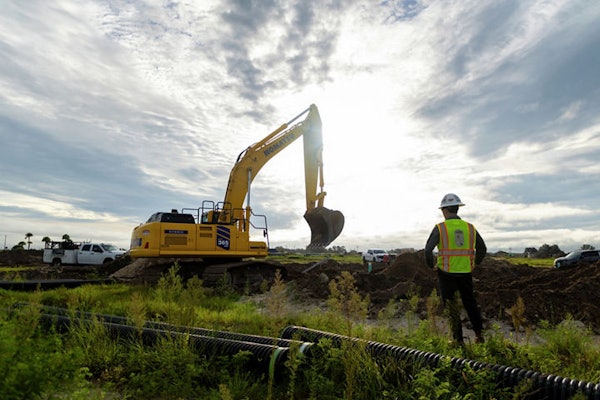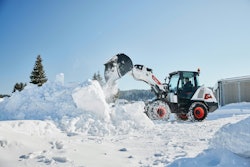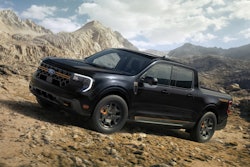Compact equipment’s popularity not only rests on its ability to be nimble in confined spaces, but also because they now offer many big machine features like high payload capacities, spacious operator stations and high flow auxiliary hydraulics. Compact wheel loaders in the 60- to 90-horsepower range can go bucket-to-bucket with similar size skid steers for many applications and frequently can match their capabilities.
For contractors working on sensitive ground coverings, a compact wheel loader’s low-impact rubber tires decrease the chances of disturbing vegetation – a minus for wheeled skid steers. On paved surfaces, compact wheel loaders roll smoothly along at up to 21 mph and won’t leave a trail of disturbed concrete or asphalt. They also have ground clearance ranges between 12 to 18 inches (Volvo’s L35B PRO has almost 2 feet of clearance).
And there’s nothing wrong with a little muscle. With their strong lift capacities and good reach heights, compact wheel loaders are loading material into trucks, placing pallets and finding favor with masonry contractors. The Komatsu WA100M-5 loader, for example, has a tipping load of 12,389 pounds.
Also keep in mind that all material moving is not up. Compact loaders in this horsepower class feature a breakout force from a low end of 9,921 pounds all the way up to Terex’s TL120 rated 15,656 pounds.
Operator comfort is a standard component in these small wheel loaders with features like electronically controlled load stabilizer-ride control (pallets aren’t the only cargo these machines carry), quiet cabs and climate controls. The high-up cabs on these loaders give operators a better look at the job and increased visibility while using attachments.
Staying grounded
Stability equals safe productivity, so manufacturers are giving articulated compact loaders a wider stance, like Case’s 78-inch-wide 321E, and additional weight such as Volvo’s L25B rear wrap-around counterweight. Lower side counterweights help Volvo’s L30B Pro and L35B Pro loaders work on steeper slopes.
Rigid-frame wheel loaders can provide stability with good ground clearance. Mustang, Gehl and Wacker are producing rigid frame models. Jay Baudhuin, product manager at Wacker Neuson, notes, “With a rigid frame compact wheel loader, your center of gravity never changes when you lift the bucket, so you don’t lose lift capacity.” The increased stability of rigid frame loaders with all-wheel-steering keeps the load level and increases material retention all the way through the lift cycle. All-wheel-steering also gives these loaders the pushing power required to drive into a pile of material, load and lift. Fitted with forks or a bucket, operators can carry and place awkward or heavy pallet loads, keeping material steady and workers safe from falling objects.
Traditional articulated compact wheel loaders have their advantages, too. Their 40-degree articulation lets them make sharp turns and eliminates rear tail swing. David Steger, national product manager for Takeuchi, says his company is seeing a number of articulated units going into recycling applications where Takeuchi contends that visibility, flexibility and capacities of a compact wheel loader are superior to skid steers.
Growing attachments and applications
Universal and skid steer-style attachment plates are available for compact wheel loaders, and with stronger hydraulics, compact wheel loaders can also handle power-hungry tools such as augers, stump grinders and power rakes. Brian Rabe, Mustang’s product specialist, anticipates more attachments designed for compact wheel loaders, saying, “The compact wheel loader market is still in its infancy in North America. Therefore, there are many specialized work tools being developed.”
Wallet size
If you measure your fuel economy in productivity, not dollars per gallon, you’ll like what compact wheel loaders can do for your company’s wallet. Compact wheel loaders are designed for day in, day out loading durability. With return-to-dig systems like those on Cat’s 906H and 908H models you get faster cycle times and more materials moved. Wear, tear and replacement of compact wheel loader tires is easier on your budget because they wear evenly as they turn, unlike the constant scraping on a skid steer.
Baudhuin says compact wheel loaders are a strong option to skid steers. “The compact wheel loader’s overall cost of ownership is lower because they have smaller engines and use less fuel. And, ergonomically, the articulated compact wheel loader will let you do almost all the same functions as a skid steer while keeping the operator more comfortable away from the work tool.”
It can be argued that compact wheel loaders cost 10 to 15 percent more to buy than a skid steer on the outset but Jeff Aubrey, product manager for Komatsu, argues the total cost of ownership is comparable or better than that of a skid steer. “Compact wheel loaders are ’10-year’ machines. They use less fuel and require fewer service intervals. Some customers report that when maintained properly, hold their value longer than skid steers,” Aubrey says.
Steger offers this advice, “When evaluating your decision, calculate the total cost of owning and operating the machine, not just the initial price tag. Take the time to compare it side by side with other contenders at your jobsite. This gives you the opportunity to see what works for you and what features each the machine truly adds value to your operation. With fuel prices, the savings from the compact wheel loader’s superior fuel efficiency will quickly add up.”
60-to-90 horsepower compact wheel loaders: New Models
John Deere
The Deere 304J’s design combines articulated frame steering with rear wheel steering (stereo steering) allowing it to turn but articulate less, keeping the center of gravity and ballast in line to make sharp turns with heavy loads. Boom float allows easy backdragging for finish grading and jobsite clean up. Return-to-dig is standard on the 304J, and the Worksite Pro skid steer-style coupler and fourth-function valve to run power attachments is optional.
Caterpillar
The universal skid steer loader-style attachment coupler on Cat’s 906H and 908H compact wheel loaders accommodates most Cat skid steer and multi terrain loader work tools. The enhanced hydraulic system increases the 906H lift capacity with forks 15 percent more than the previous Cat model and has a 7-percent larger operating bucket load capacity. An optional high-speed configuration raises both loaders’ travel speeds to 22 mph.
JCB
JCB’s 409ZX compact loader features limited slip differentials with portal axles for harsh applications requiring traction and high ground clearance. High lift loader configurations are available for high tearout and loadover applications. Both JCB models accept other buckets and attachments using an industry standard quick hitch.
Gehl
Gehl’s one piece, rigid frame compact wheel loaders with all-wheel-steering maintains the machine’s center of gravity during sharp turns, keeping it stable and at full rated operating capacity throughout the entire turn.
Wacker Neuson
The articulated WL50 and 850 rigid frame models are two of six new wheel loaders from Wacker Neuson. Both models feature four-wheel-drive and universal adaptor plates that accept Wacker’s rock rakes, grapple buckets, augers, 4-in-1 buckets and most other manufacturer’s attachments.
60-to-90 horsepower compact wheel loaders: Current Models
Case
The Case E-Series compact wheel loaders’ Versa-Boom design enhances the operator’s view of the coupler and attachments throughout the lift cycle, allowing precise positioning. The parallel lift on the Case loaders has a variance of less than one degree through the complete lift cycle for more accurate material handling.
Komatsu
Optional manual speed selection (creeper gear) on the Komatsu compact wheel loaders allows maximum hydraulic flow to front mounted hydraulic attachments without operating machine at maximum travel speed. Hydraulic front attachment quick-coupler and attachments for the Dash 5 series are interchangeable with the Dash 3 loaders. Rear axle-oscillation adds stability for digging applications. The electronically controlled load stabilizer ride system keeps materials steady.
Mustang
Mustang’s all-wheel-steer ML68 compact wheel loader features the Skid-a-Tach adapter that connects to almost any skid steer attachment. An optional two-speed Ecospeed high-speed drive configuration allows the loader to reach speeds up to 25 mph. The one-piece chassis and 2-by-40-degree four-wheel steering provides easy handling.
New Holland
New Holland’s W80TC compact wheel loaders have a new universal link boom design that features one lift cylinder and one bucket cylinder. Its two separate hydraulic pumps provide more output for hydraulic attachments. The 54-degree bucket rollback allows operators to completely invert the bucket to grade or pull material away from foundations. Optional anti-drop valve prevents accidental loss of pressure.
Takeuchi
The skid steer loader-style attachment adaptor coupler allows Takeuchi’s TW60 and TW80 loaders to operate a variety of attachments. Tie down points are integrated into the counterweights, and momentary pushbutton control of 100 percent front and rear axle differential locks provide additional traction in harsh terrain.
Terex
Terex’s TL100 and TL120 compact wheel loaders feature transverse-mounted engines for stability while lifting and transporting heavy payloads. An oscillating rear axle maintains 4-wheel traction on rough terrain. A ride control system and high-speed travel configuration is available. Optional attachments include a super light-material bucket, side-dump bucket and 2.4-cubic-yard high-tip bucket.
Volvo
Volvo’s compact wheel loader’s quick couplers connect to more than 60 skid steer and full size wheel loader attachments without requiring the operator to leave the cab. The 100-percent operator selectable differential locks on both axles allow the loader to maneuver on unstable terrain.









